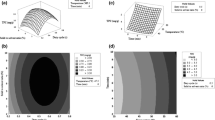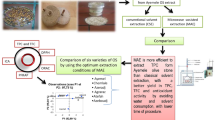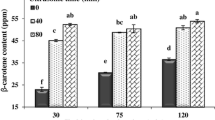Abstract
Health hazards of artificial antioxidants have motivated use of natural phenolic compounds in food industry. Olive-waste cake, resulted from olive oil extraction, is accounted as a rich resource of phenolic compounds. In this study, extraction of phenolic compounds through sonication process was investigated. In this respect, effects of sample weight to solvent ratio (in three levels of 1:10, 1:30 and 1:50) and sonication time (in three levels of 10, 30 and 50 min) were evaluated on total phenolic content, antioxidant activity and color parameters of L* and a* of the extracts. Results showed that changing the independent variable of sample weight to solvent ratio from 1:50 to 1:10 results in a significant increase in total phenolic content and antioxidant activity parameters (P ≤ 0.01) and a significant reduction of L* color parameter (P ≤ 0.01) of the extracts. Also, the results of this study demonstrated that prolonging sonication time from 10 to 50 min provides significant increase of L* color parameter (P ≤ 0.01) and insignificant enhancement of total phenolic content and antioxidant activity (P > 0.05) while it reduces a* color parameter of the extracts, significantly (P ≤ 0.01). Based on Fourier transform infrared spectra of the treatments, ultrasound waves do not impose any destructive impact on functional groups of the extracts. Moreover, scanning electron microscopy images of the olive-waste cake powders showed higher porosity in the microstructure of the sonicated solid residues, specifically when longer ultrasonic times were applied.



Similar content being viewed by others
References
S. Djilas, J. Canadanovic-Brunet, G. Cetkovic, Antioxidants in food. Hem. Ind. 56, 105–112 (2002)
D. Bera, D. Lahiri, A. Nag, Studies on a natural antioxidant for stabilization of edible oil and comparison with synthetic antioxidants. J. Food Eng. 74, 542–545 (2006)
A. Tafesh et al., Synergistic antibacterial effects of polyphenolic compounds from olive mill wastewater. Evid. Based Complement. Altern. Med. 2011, 1–9 (2011)
F. Alagna et al., Olive phenolic compounds: metabolic and transcriptional profiling during fruit development. BMC Plant Biol. 12, 162 (2012)
F. Aouidi et al., Rapid quantitative determination of oleuropein in olive leaves (Olea europaea) using mid-infrared spectroscopy combined with chemometric analyses. Ind. Crops Prod. 37, 292–297 (2012)
F. Mazzotti et al., Assay of tyrosol and hydroxytyrosol in olive oil by tandem mass spectrometry and isotope dilution method. Food Chem. 135, 1006–1010 (2012)
E. Marco, De et al., Characterization and fractionation of phenolic compounds extracted from olive oil mill wastewaters. Food Chem. 104, 858–867 (2007)
N.S. Kumar, K. Min, Phenolic compounds biosorption onto Schizophyllum commune fungus: FTIR analysis, kinetics and adsorption isotherms modeling. Chem. Eng. J. 168, 562–571 (2011)
J. Azmir et al., Techniques for extraction of bioactive compounds from plant materials: a review. J. Food Eng. 117, 426–436 (2013)
Y. Picó, Ultrasound-assisted extraction for food and environmental samples. TrAC Trends Anal. Chem. 43, 84–99 (2013)
Y. Tao, Z. Zhang, D.-W. Sun, Kinetic modeling of ultrasound-assisted extraction of phenolic compounds from grape marc: influence of acoustic energy density and temperature. Ultrason. Sonochem. 21, 1461–1469 (2014)
M.C. Herrera, M.D. Luque de Castro, Ultrasound-assisted extraction for the analysis of phenolic compounds in strawberries. Anal. Bioanal. Chem. 379, 1106–1112 (2004)
G. Zu et al., Ultrasound-assisted extraction of carnosic acid and rosmarinic acid using ionic liquid solution from rosmarinus officinalis. Int. J. Mol. Sci. 13, 11027–11043 (2012)
C. Carrera, A. Ruiz-rodríguez, M. Palma, C.G. Barroso, Ultrasound assisted extraction of phenolic compounds from grapes. Anal. Chim. Acta 732, 100–104 (2012)
C. Corbin et al., Development and validation of an efficient ultrasound assisted extraction of phenolic compounds from flax (Linum usitatissimum L.) seeds. Ultrason. Sonochem. 26, 176–185 (2015)
J. Wang, B. Sun, Y. Cao, Y. Tian, X. Li, Optimisation of ultrasound-assisted extraction of phenolic compounds from wheat bran. Food Chem. 106, 804–810 (2008)
S. Şahin, R. Şamli, Optimization of olive leaf extract obtained by ultrasound-assisted extraction with response surface methodology. Ultrason. Sonochem. 20, 595–602 (2013)
C. Soto, E. Caballero, E. Pérez, M. Elvira, M.E. Zúñiga, Effect of extraction conditions on total phenolic content and antioxidant capacity of pretreated wild Peumus boldus leaves from Chile. Food Bioprod. Process 92, 328–333 (2014)
S. Chanda, R. Dave, In vitro models for antioxidant activity evaluation and some medicinal plants possessing antioxidant properties: an overview. Afr. J. Microbiol. Res. 3, 981–996 (2009)
A. El-Abbassi, H. Kiai, A. Hafidi, Phenolic profile and antioxidant activities of olive mill wastewater. Food Chem. 132, 406–412 (2012)
S. Haji Heidari, S. Taghian Dinani, The study of ultrasound-assisted enzymatic extraction of oil from peanut seeds using response surface methodology. Eur. J. Lipid Sci. Technol. (2017). https://doi.org/10.1002/ejlt.201700252
S. Taghian Dinani, N. Hamdami, M. Shahedi, M. Havet, D. Queveau, Influence of the electrohydrodynamic process on the properties of dried button mushroom slices: a differential scanning calorimetry (DSC) study. Food Bioprod. Process 95, 83–95 (2015)
Y. Sun, G. Ma, X. Ye, Y. Kakuda, R. Meng, Stability of all-trans-β-carotene under ultrasound treatment in a model system: effects of different factors, kinetics and newly formed compounds. Ultrason. Sonochem. 17, 654–661 (2010)
D.L. Luthria, Optimization of extraction of phenolic acids from a vegetable waste product using a pressurized liquid extractor. J. Funct. Foods 4, 842–850 (2012)
K. Ghafoor, Y.H. Choi, J.Y. Jeon, I.H. Jo, Optimization of ultrasound-assisted extraction of phenolic compounds, antioxidants, and anthocyanins from grape (Vitis vinifera) seeds. J. Agric. Food Chem. 57, 4988–4994 (2009)
M. Brenes-Balbuena, P. Garcia-Garcia, A. Garrido-Fernandez, Phenolic compounds related to the black color formed during the processing of ripe olives. J. Agric. Food Chem. 40, 1192–1196 (1992)
R.D.A. Amaral, B.C. Benedetti, M. Pujola, I. Achaerandio, M.L. Bachelli, B. Effect of ultrasound on quality of fresh-cut potatoes during refrigerated storage. Food Eng. Rev. 7, 176–184 (2015)
M.G.M. Costa et al., High-intensity ultrasound processing of pineapple juice. Food Bioprocess Technol. 6, 997–1006 (2013)
A.B. Cabezas-Serrano, M.L. Amodio, R. Cornacchia, R. Rinaldi, G. Colelli, Suitability of five different potato cultivars (Solanum tuberosum L.) to be processed as fresh-cut products. Postharvest Biol. Technol. 53, 138–144 (2009)
A.O. Adekunte, B.K. Tiwari, P.J. Cullen, A.G.M. Scannell, C.P. O’Donnell, Effect of sonication on colour, ascorbic acid and yeast inactivation in tomato juice. Food Chem. 122, 500–507 (2010)
B. Saberi, S. Chockchaisawasdee, J.B. Golding, C.J. Scarlett, C.E. Stathopoulos, Physical and mechanical properties of a new edible film made of pea starch and guar gum as affected by glycols, sugars and polyols. Int. J. Biol. Macromol. 104, 345–359 (2017)
T. Suganya, S. Renganathan, Optimization and kinetic studies on algal oil extraction from marine macroalgae Ulva lactuca. Bioresour. Technol. 107, 319–326 (2012)
X. Lu, C.F. Ross, J.R. Powers, D.E. Aston, B.A. Rasco, Determination of total phenolic content and antioxidant activity of garlic (Allium sativum) and elephant garlic (Allium ampeloprasum) by attenuated total reflectance–Fourier transformed infrared spectroscopy. J. Agric. Food Chem. 59, 5215–5221 (2011)
X.N. Lu, C.F. Ross, J.R. Powers, B.A. Rasco, Determination of quercetins in onion (Allium cepa) using infrared spectroscopy. J. Agric. Food Chem. 59, 6376–6382 (2011)
J. He, L.E. Rodriguez-Saona, M.M. Giusti, Midinfrared spectroscopy for juice authentication-rapid differentiation of commercial juices. J. Agric. Food Chem. 55, 4443–4452 (2007)
X. Lu et al., Infrared and Raman spectroscopic studies of the antimicrobial effects of garlic concentrates and diallyl constituents on foodborne pathogens. Anal. Chem. 83, 4137–4146 (2011)
H. Sohrabi, E. Ameri, Adsorption equilibrium, kinetics, and thermodynamics assessment of the removal of the reactive red 141 dye using sesame waste. Desalin. Water Treat. 57, 18087–18098 (2016)
X. Lu et al., Determination of total phenolic content and antioxidant capacity of onion (Allium cepa) and shallot (Allium oschaninii) using infrared spectroscopy. Food Chem. 129, 637–644 (2011)
M.M. Kamil, G.F. Mohamed, M.S. Shaheen, Fourier Transformer Infrared spectroscopy for quality assurance of tomato products. J. Am. Sci. 27, 253–260 (2011)
K. Sinha, P. Saha, S. Das, Datta, Extraction of natural dye from petals of Flame of forest (Butea monosperma) flower: process optimization using response surface methodology (RSM). Dyes Pigm. 94, 212–216 (2012)
Author information
Authors and Affiliations
Corresponding author
Rights and permissions
About this article
Cite this article
Khalili, F., Taghian Dinani, S. Extraction of phenolic compounds from olive-waste cake using ultrasonic process. Food Measure 12, 974–981 (2018). https://doi.org/10.1007/s11694-017-9712-1
Received:
Accepted:
Published:
Issue Date:
DOI: https://doi.org/10.1007/s11694-017-9712-1




